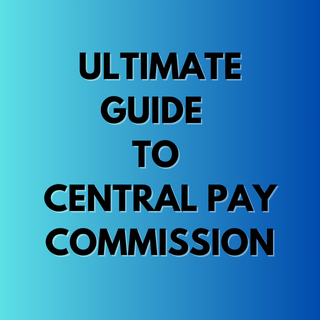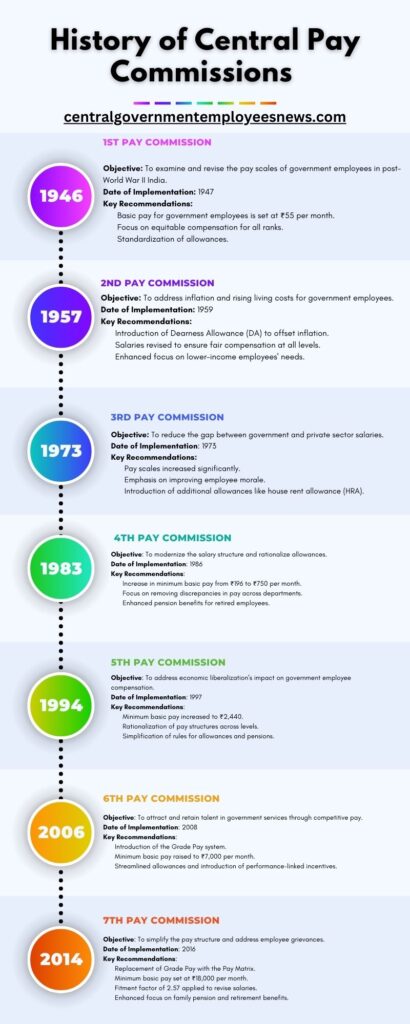
The Ultimate Guide to the Central Pay Commission (CPC)
The Central Pay Commission (CPC) is a pivotal mechanism in the governance of India, shaping the financial well-being of millions of government employees and pensioners. This comprehensive guide provides an in-depth understanding of the CPC, its history, purpose, and impact, while addressing frequently asked questions and exploring key trends.
What is the Central Pay Commission?
The Central Pay Commission is an advisory body established by the Government of India to evaluate and recommend changes in the salary structure, allowances, and benefits of central government employees, defense personnel, and pensioners. These recommendations ensure fair compensation and address the economic needs of government employees in alignment with inflation and economic growth.
Timeline: History of Central Pay Commissions in India
1st Pay Commission (1946)

- Objective: To examine and revise the pay scales of government employees in post-World War II India.
- Date of Implementation: 1947
- Key Recommendations:
- Basic pay for government employees is set at ₹55 per month.
- Focus on equitable compensation for all ranks.
- Standardization of allowances.
2nd Pay Commission (1957)
- Objective: To address inflation and rising living costs for government employees.
- Date of Implementation: 1959
- Key Recommendations:
- Introduction of Dearness Allowance (DA) to offset inflation.
- Salaries revised to ensure fair compensation at all levels.
- Enhanced focus on lower-income employees’ needs.
3rd Pay Commission (1973)
- Objective: To reduce the gap between government and private sector salaries.
- Date of Implementation: 1973
- Key Recommendations:
- Pay scales increased significantly.
- Emphasis on improving employee morale.
- Introduction of additional allowances like house rent allowance (HRA).
4th Pay Commission (1983)
- Objective: To modernize the salary structure and rationalize allowances.
- Date of Implementation: 1986
- Key Recommendations:
- Increase in minimum basic pay from ₹196 to ₹750 per month.
- Focus on removing discrepancies in pay across departments.
- Enhanced pension benefits for retired employees.
5th Pay Commission (1994)
- Objective: To address economic liberalization’s impact on government employee compensation.
- Date of Implementation: 1997
- Key Recommendations:
- Minimum basic pay increased to ₹2,440.
- Rationalization of pay structures across levels.
- Simplification of rules for allowances and pensions.
6th Pay Commission (2006)
- Objective: To attract and retain talent in government services through competitive pay.
- Date of Implementation: 2008
- Key Recommendations:
- Introduction of the Grade Pay system.
- Minimum basic pay raised to ₹7,000 per month.
- Streamlined allowances and introduction of performance-linked incentives.
7th Pay Commission (2014)
- Objective: To simplify the pay structure and address employee grievances.
- Date of Implementation: 2016
- Key Recommendations:
- Replacement of Grade Pay with the Pay Matrix.
- Minimum basic pay set at ₹18,000 per month.
- Fitment factor of 2.57 applied to revise salaries.
- Enhanced focus on family pension and retirement benefits.
What Does the Central Pay Commission Do?
The CPC evaluates:
- Pay Structure: Reviews salary frameworks to ensure fairness.
- Allowances: Recommends adjustments in dearness allowance, house rent allowance (HRA), and travel allowances.
- Pensions: Suggests pension reforms for retired government employees.
- Work Conditions: Analyzes the working conditions of employees to align with modern requirements.
Key Features of the 7th Central Pay Commission
- Pay Matrix: Simplifies salary structure into levels and cells, replacing the Grade Pay system.
- Minimum Pay: Set at ₹18,000 per month for the lowest-paid employee.
- Fitment Factor: Salaries multiplied by a factor of 2.57 for revised pay.
- Revised Allowances: Changes in HRA, transport allowance, and children’s education allowance.
8th Central Pay Commission: What to Expect
Although there’s no official announcement, speculation suggests:
- Higher DA Revisions: Expected linkage with inflation indices.
- Digital Integration: Focus on online salary and benefits management.
- New Pay Matrix Levels: Addressing disparities in middle-level posts.
FAQs about the Central Pay Commission
1. How often is the Central Pay Commission formed?
The CPC is typically constituted every 10 years to revise pay structures.
2. What is Dearness Allowance (DA)?
DA is a cost-of-living adjustment allowance provided to government employees and pensioners to offset inflation.
3. Is the 8th CPC confirmed?
While not officially announced, discussions suggest it may be constituted around 2025.
4. What is the 7th Pay Commission Pay Matrix?
The 7th Pay Commission introduced the Pay Matrix as a simplified salary structure for central government employees. It replaces the earlier Grade Pay system with a clear table of levels (based on ranks) and cells (increments). The Pay Matrix standardizes salaries, making it easy to calculate revised pay by multiplying the basic pay with the fitment factor of 2.57. This matrix applies to all categories of employees, ensuring uniformity and transparency in pay revisions.
5. Expected Date for 8th Central Pay Commission
While the government has not officially announced the formation of the 8th Central Pay Commission, trends suggest it may be constituted around 2025, following the 10-year interval tradition. Employees and pensioners are eagerly anticipating changes such as enhanced pay scales, higher allowances, and digitalized processes. Stay updated as discussions and recommendations progress.
6. Benefits of 7th Pay Commission for Pensioners
The 7th Pay Commission brought significant improvements for pensioners. Key benefits include:
- Pension recalculation based on the Pay Matrix.
- Higher minimum pensions, starting at ₹9,000 per month.
- Introduction of the fitment factor (2.57) to adjust pensions to current levels.
- Simplified rules for family pensions and improved dearness relief adjustments to offset inflation.
These changes have greatly improved financial stability for retired employees.
Impact of the Central Pay Commission
The CPC significantly influences:
- Economic Stability: Enhances purchasing power of government employees.
- Social Welfare: Ensures equitable compensation for the workforce.
- Budget Planning: Plays a critical role in India’s financial strategy.
Conclusion
The Central Pay Commission continues to be a cornerstone of India’s public sector framework, addressing the needs of government employees and adapting to changing times. With the 8th CPC on the horizon, its recommendations will likely set new benchmarks in employee welfare and economic governance.
Stay Updated
Check out our website for the latest updates on the 8th Central Pay Commission and other important developments in government policies.
Leave a Reply